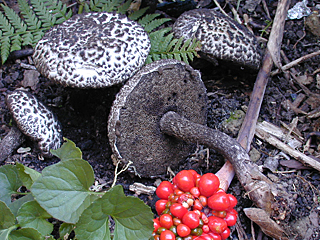"Out of control," said Rick Van de Poll, reporting from Sandwich, N.H. Van de Poll, an environmental consultant, has been collecting mushrooms for more than three decades. Only the crops of 1985 and 1993, he said, compare to this year.
The 2003 crop "was no slouch, but it was better for fall fungi," Van de Poll said. "Right now, the general smell in the woods, if your nose is tuned in, is of rotting fruit bodies."
The interim since 2003 also improved conditions for this year's bounty, said Lawrence Millman, a Cambridge author and mycologist, as exhausted mycelium had time to recover from the 2003 fruiting. "It was about right - every three, or four, or five years - and this year's rain simply encouraged it," Millman said.
There are thousands of species of mushrooms that burst forth when conditions are right with bulbs and caps in craggy shelves and huddled clusters, and more. The mushrooms survive for a few hours or weeks, depending on species; some prefer spring, others summer or fall.
They lure those seeking rich tastes, subjects for photos and painted portraits, or rich dyes, as chemicals in some fungi adhere well to animal fibers such as wool. Pisolithus tinctorius, a mushroom that lives in concert with certain trees, primarily conifers, is, according to Ellen Neelands, president of the 113-year-old Boston Mycological Club, "a wonderful dyer, yielding a lovely, complex, dark brown color."
Shapes, colors, and composition also fascinate scientists and others who want to know exactly how things work. Experimenters of another sort favor certain mushrooms, which grow in New England only very occasionally but can cause hallucinations.
This year, though, even the usually disinterested among us are captivated by more kinds of mushrooms, in larger quantity - whether clumps of black trumpets or giant puffballs - popping up in the yard more or less overnight.
"Everybody is coming up to me and saying, 'Can you tell me what's growing in our garden?' " said Vivienne Woodhead, who another year led a mushroom excursion on her property in Gloucester.
Such celebration also comes with concern; mushrooms can be delicious and delightful but also deadly. Certain fatal types, for example, destroy a person's liver.
Local hospitals have seen a spike in calls, mostly from parents of toddlers who had popped mushrooms in their mouths. Most tastings have turned out to be harmless, and there have been no fatalities this year, according to Alfred Aleguas, clinical manager with the Regional Center for Poison Control and Prevention Serving Massachusetts and Rhode Island. (Neelands heard from a veterinary student who was concerned after a dog had gone grazing.)
One close call came before a neighbor contacted Shavit, a contributing editor to Fungi magazine known for her ability to identify different species. The neighbor told Shavit she had picked 30 pounds of chanterelles, an elegant, edible specimen that is tasty when sauteed in oil with shallots and salt. On closer inspection, Shavit determined the suspected chanterelles were Omphalotus illudens, or Jack O' Lantern mushrooms, known to spur vomiting and diarrhea.
Norman "Dugie" Russell, who helps Children's Hospital Boston and Beverly Hospital with emergency mushroom identifications, warns casual pickers to study guidebooks and seek expert advice.
"You can't just sit down [to eat] and say, 'I'm pretty sure I know what this is,' " Russell said.
Not that mushrooms need to be eaten to be enjoyed. Two friends strolling the woods of Appleton Farms in Ipswich recently spotted a classic kind of mushroom, a firm stalk topped with a round cap colored crimson and white. One of the women, from New York City, said it looked like it should be in a gift shop. Or perhaps, added the other woman, it belonged in a toadstool story.
An unexpected encounter some years ago spurred Vladimir Gubenko, a self-proclaimed amateur mycologist, on an adventure that has become a bit of an addiction.
"I went to Boynton Park in Worcester, and I saw a fairy ring [mushroom] for the first time in my life," Gubenko said. "It was a giant thing, 50 feet in diameter."
On a recent sun-stroked morning, during one of his frequent strolls along a rutted trail in Grafton, Gubenko, walking stick in hand, stooped to examine two boletes. They were 3 inches across, with a yellowish sponge beneath the caps. Only a week old, they were already past their prime.
"You would have had two very delicious mushrooms," Gubenko said.
Just across the trail, the elegant stem of some type of amanita - a genus of mushrooms with particularly poisonous species - supported a dandy of a khaki cap. Nearby, a flat-topped mushroom with floppy gills rose only 2 inches above ground.
"I have no idea what this one is," Gubenko said. "I think it's pretty, though."
Beneath a clump of moss, dainty, defiant white bulbs stood strong above the mud. The slimy, purple cap of a single mushroom brightened the scene near a fallen tree trunk. Silky black trumpets blurred among brown leaves.
Anyone interested in exploring this world can join one of the active clubs in the region, such as the Boston Mycology Club or the Sandwich Area Mushroom Club, or one of many e-mail groups that trade tips and information. Many species of mushrooms, after all, have never been scientifically identified.
"You might one of these days find something nobody has found before," Gubenko said. "I think that is wonderful, looking for something new."
Reprinted with permission.
© Copyright 2008 Globe Newspaper Company.
|
![]()













